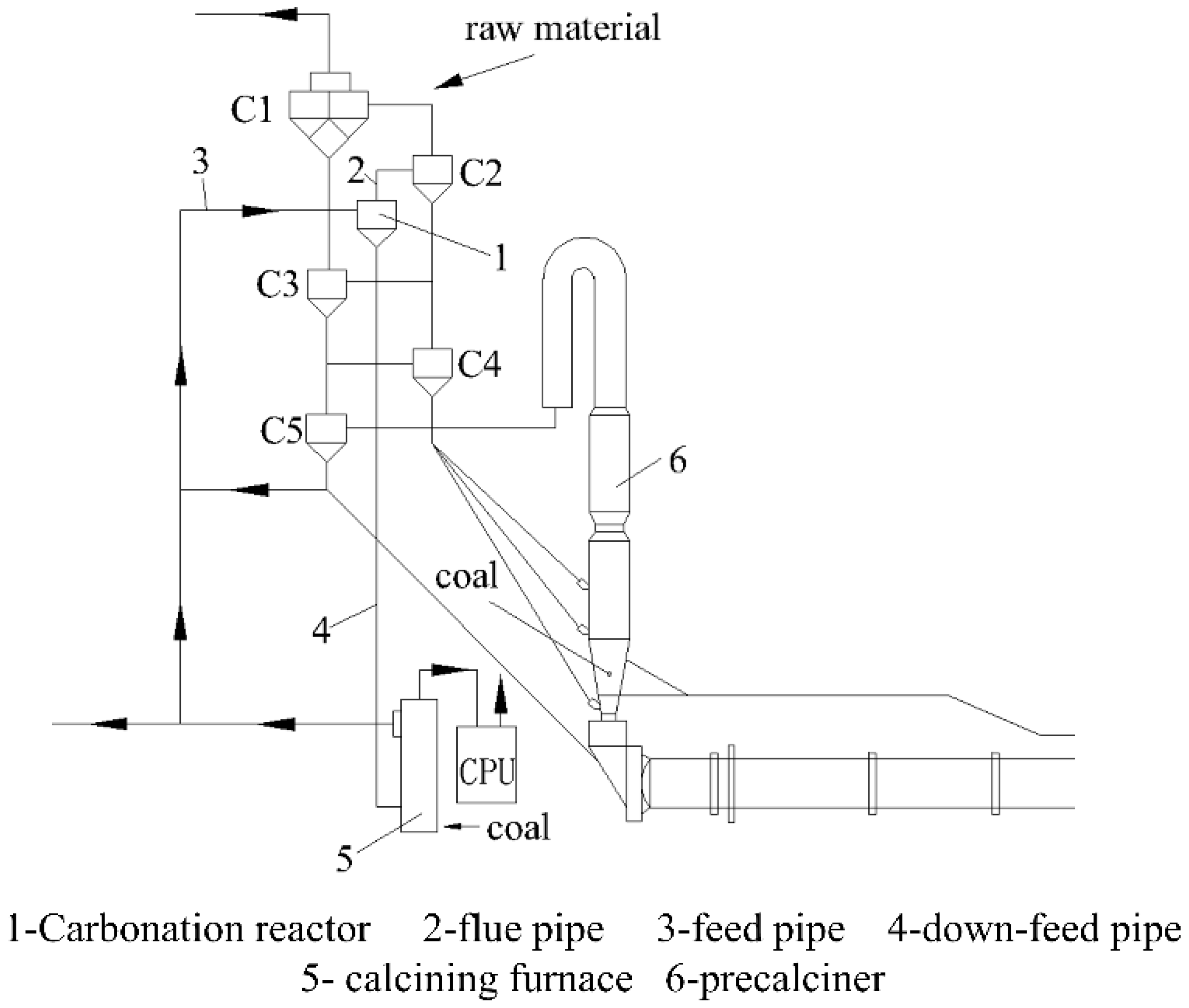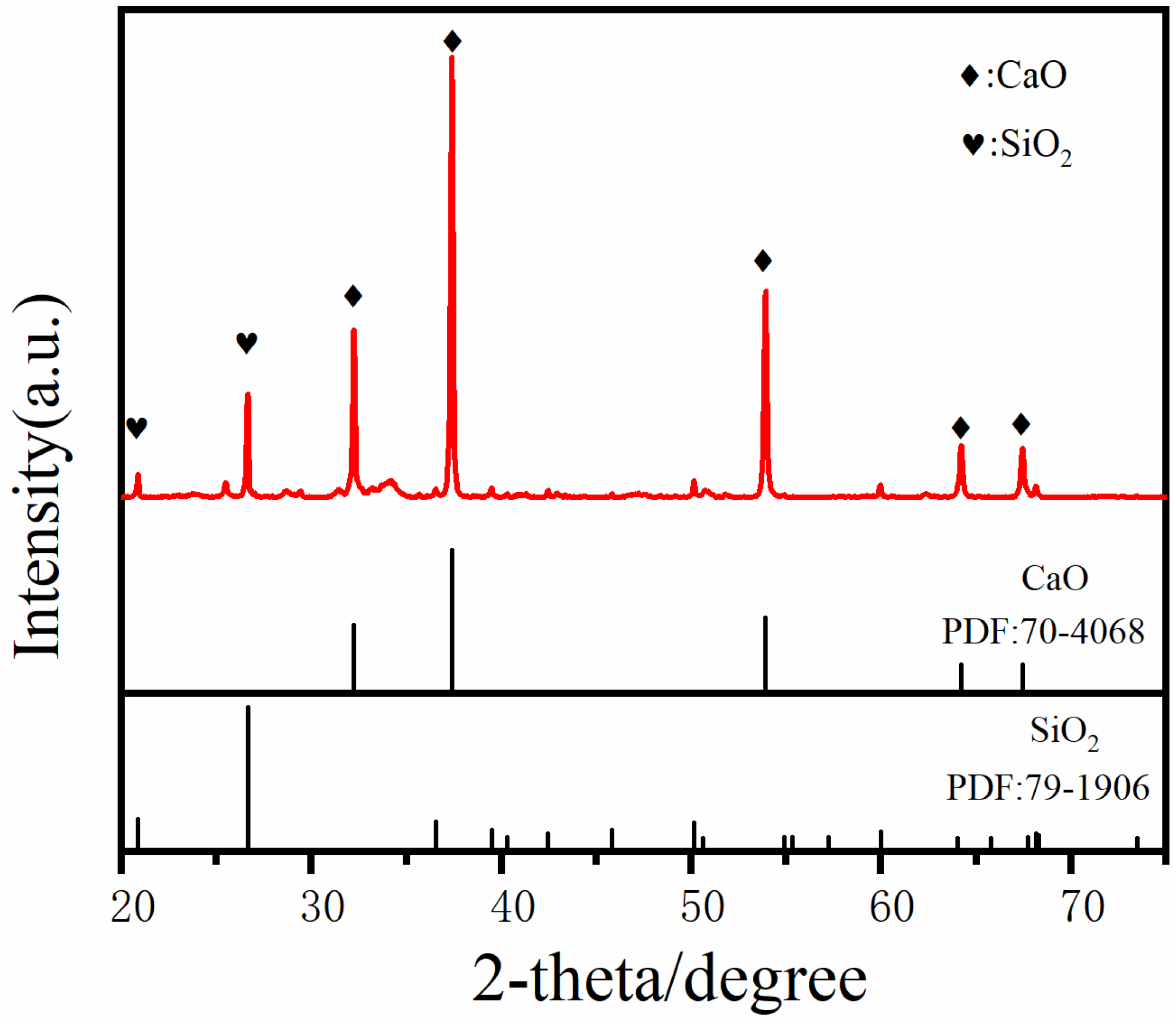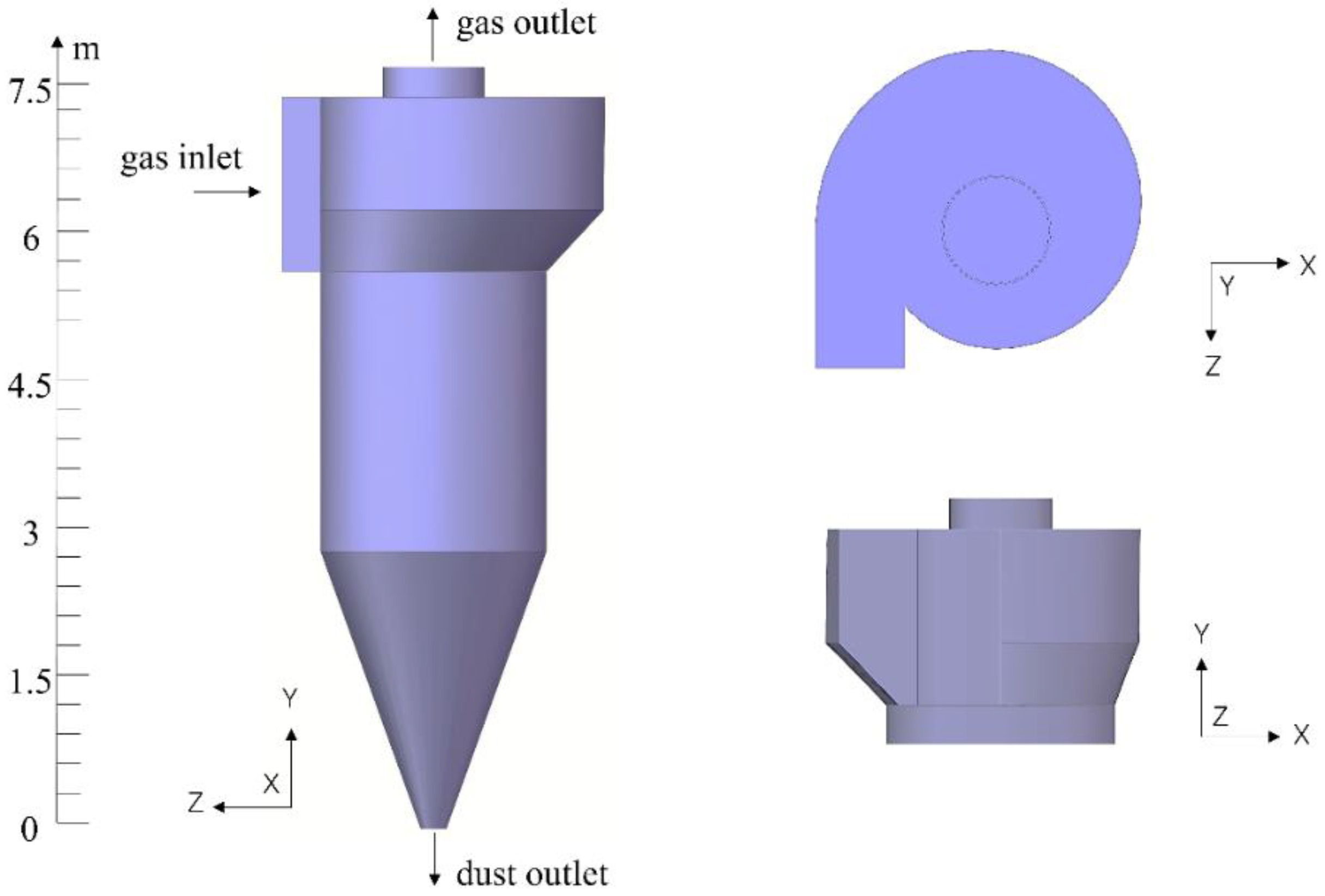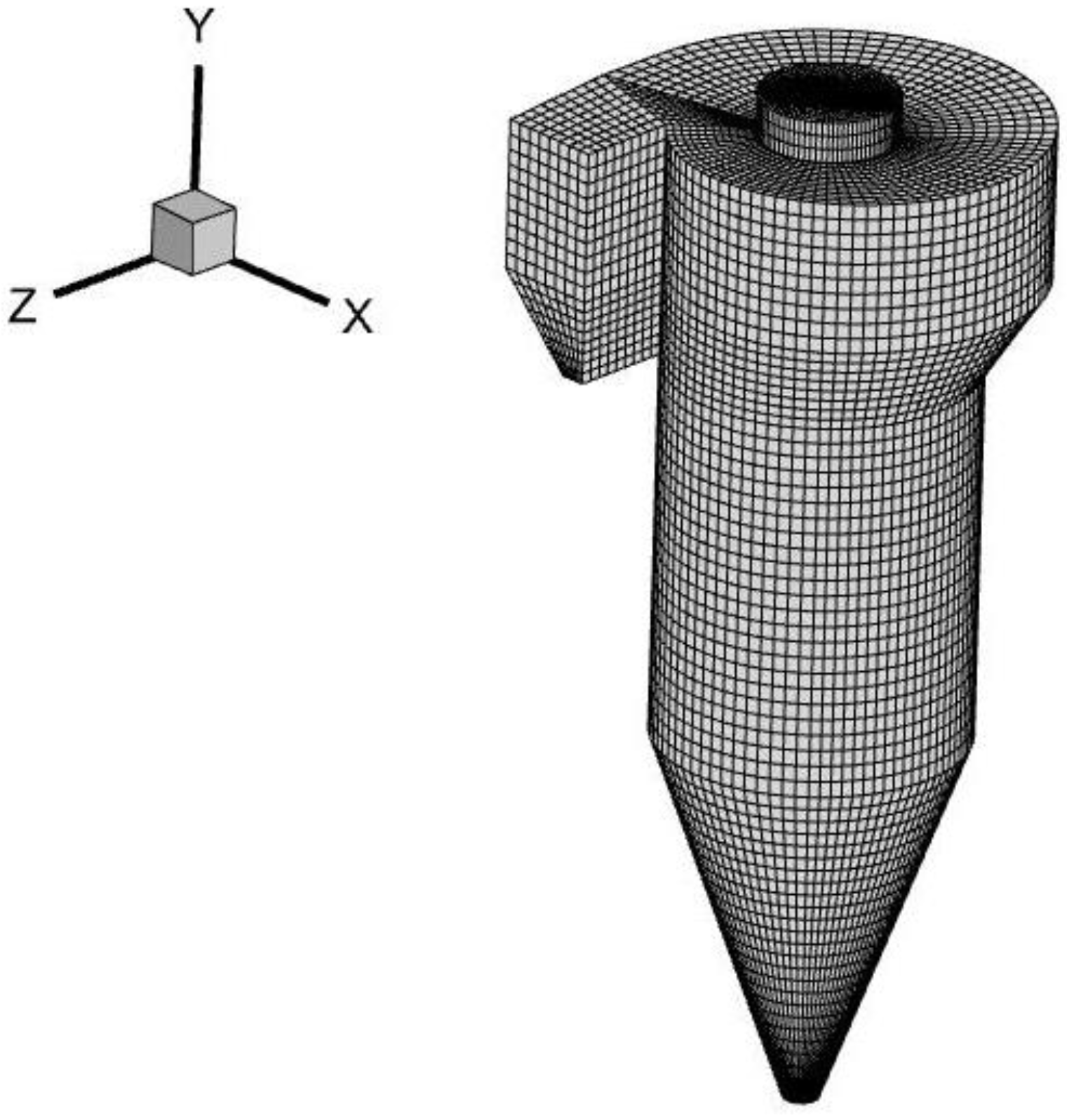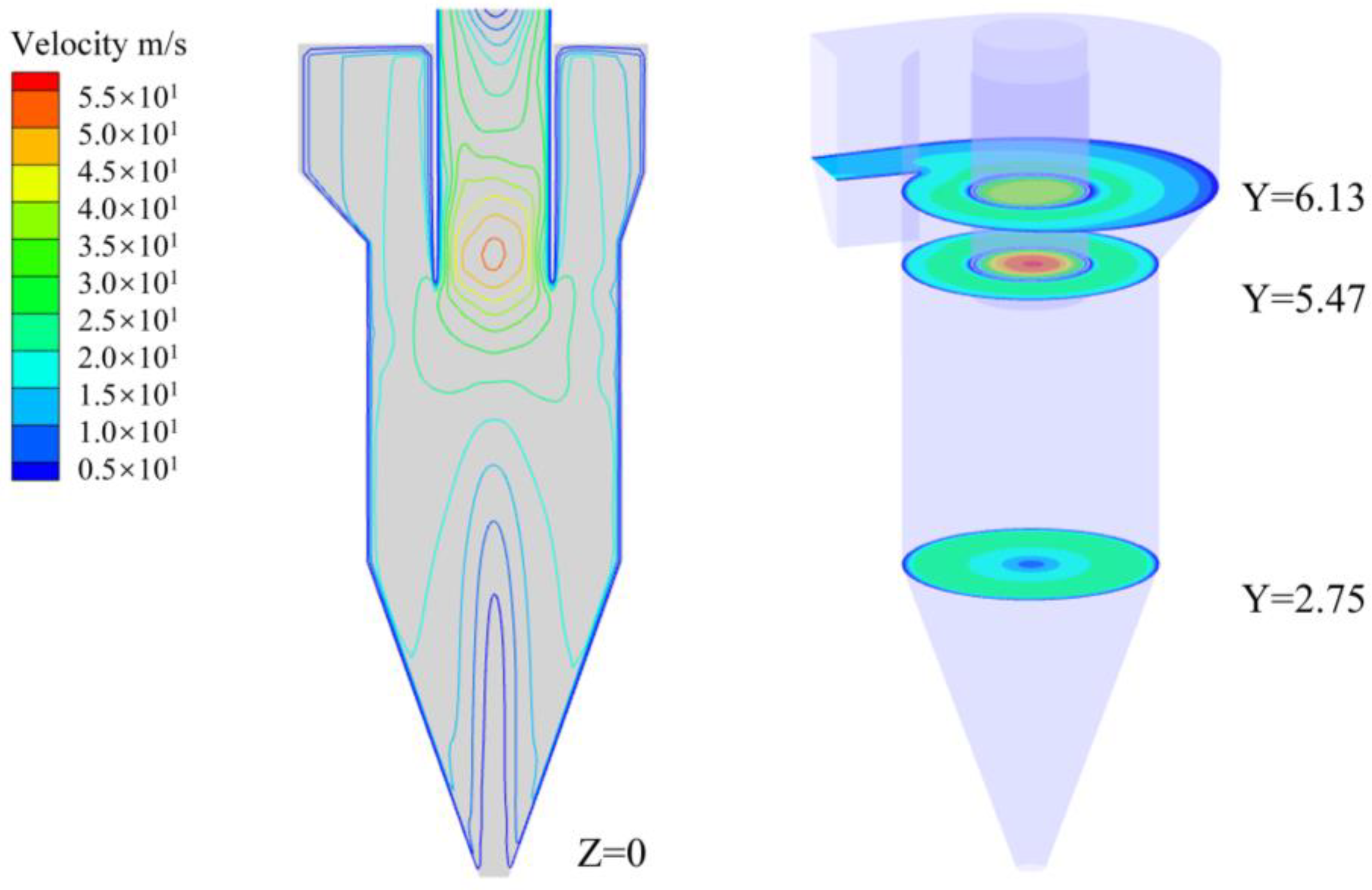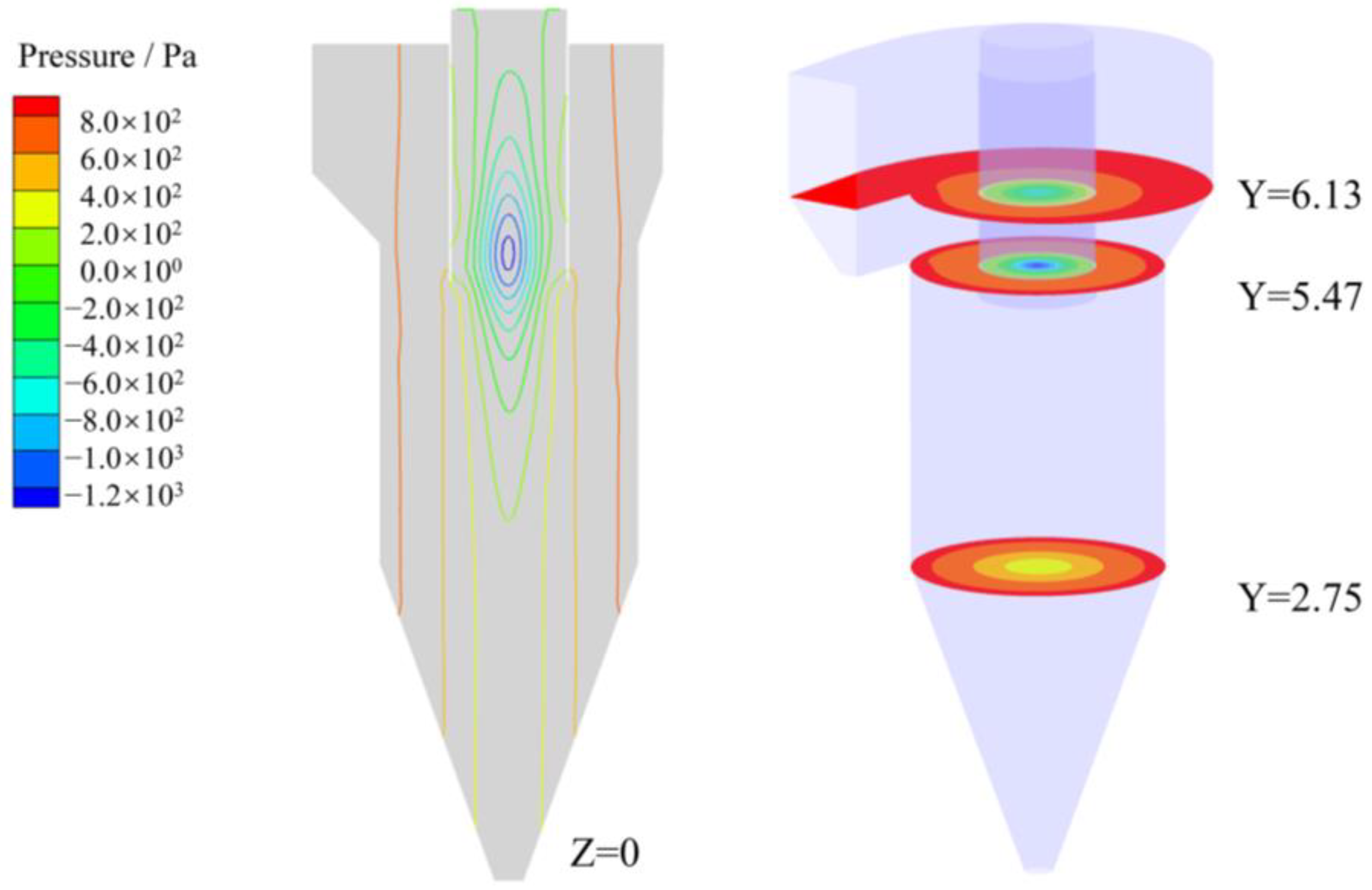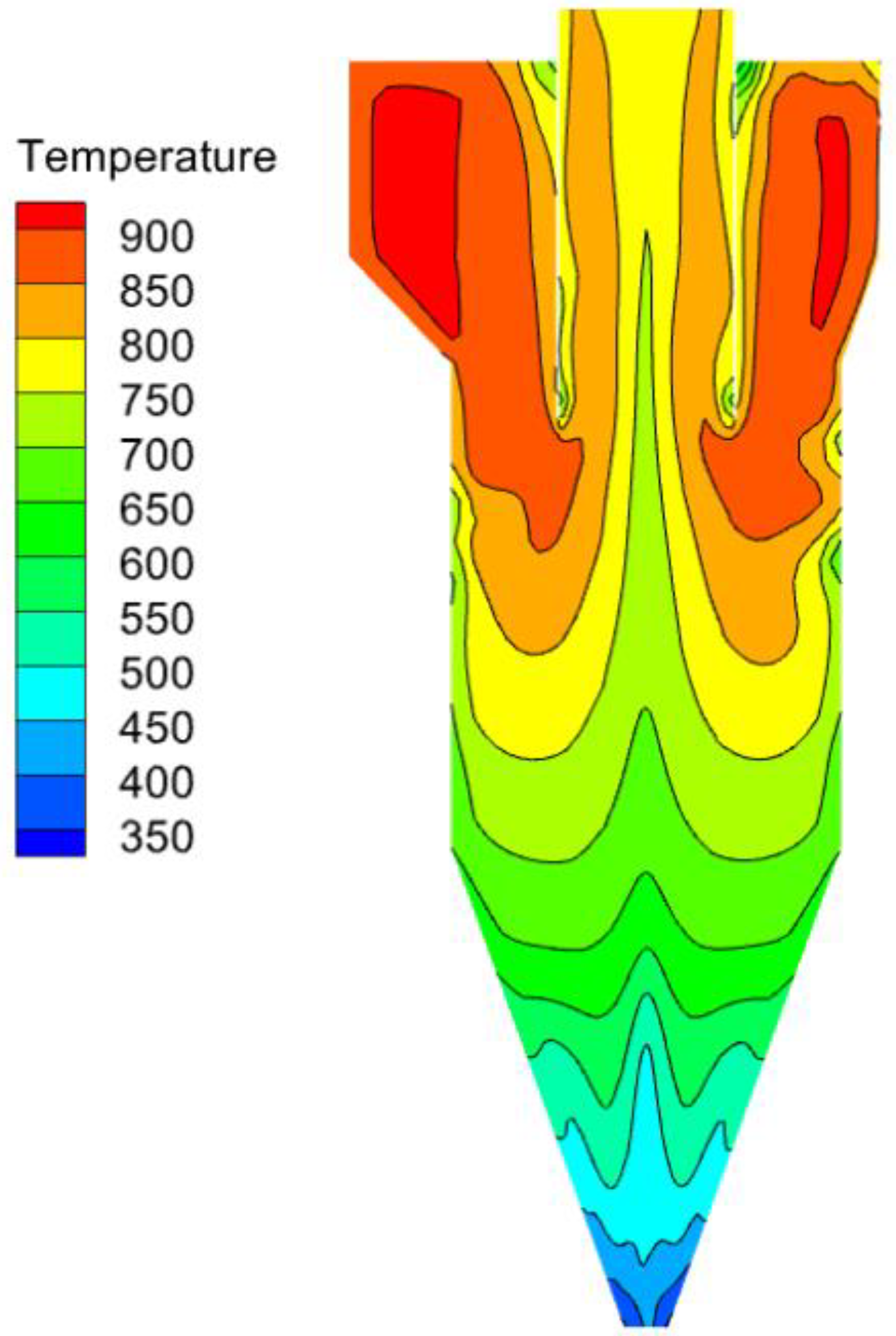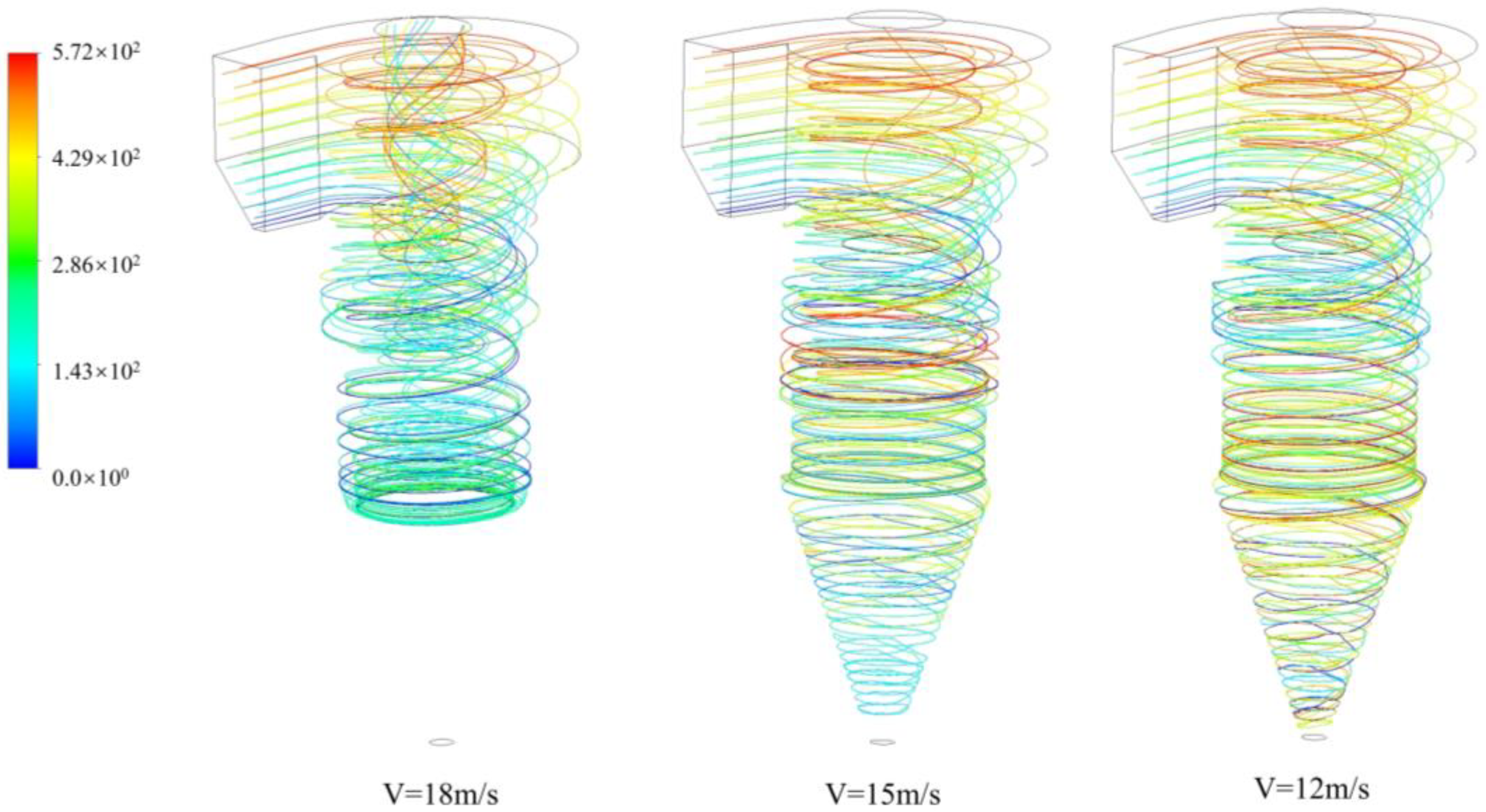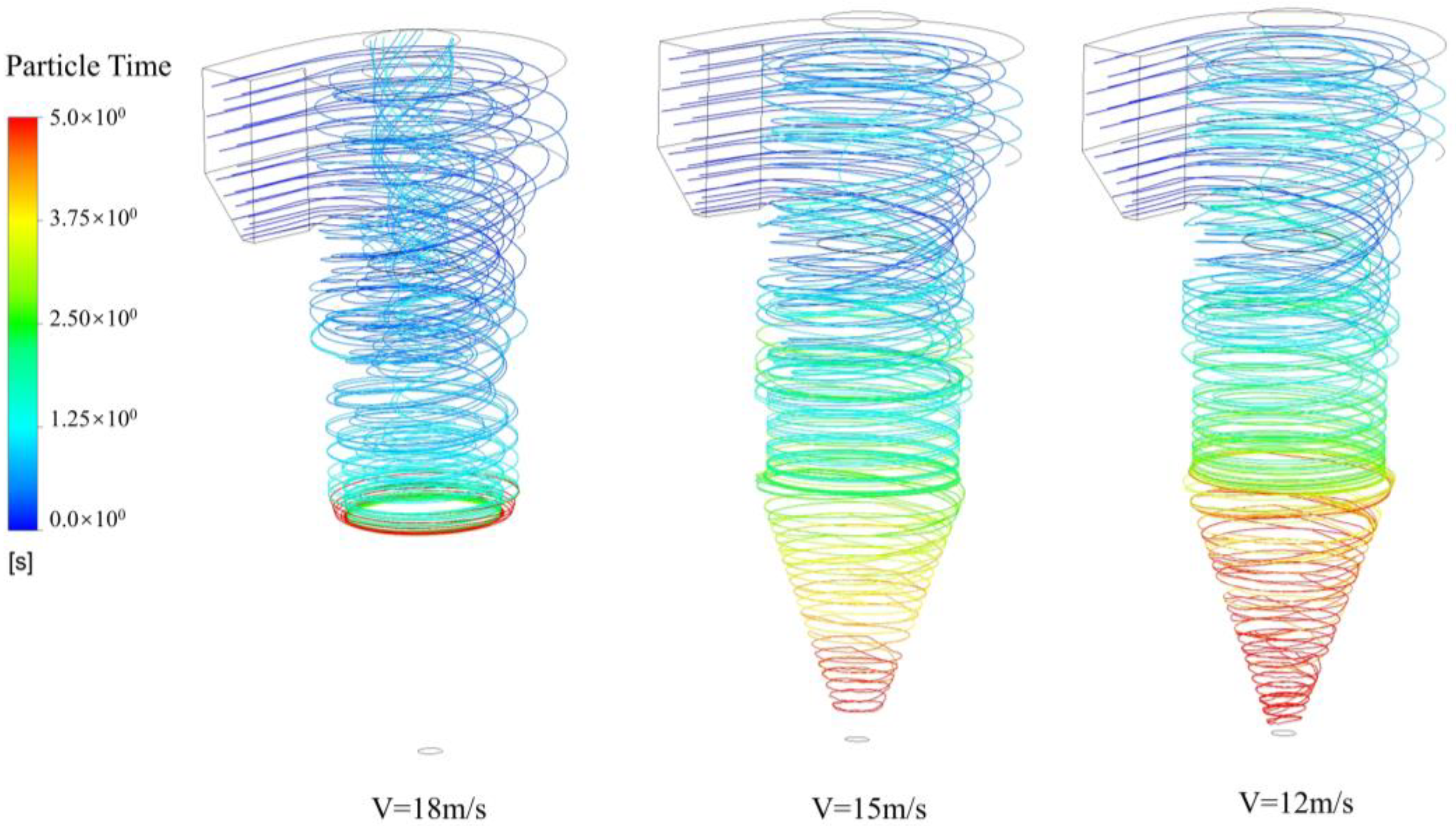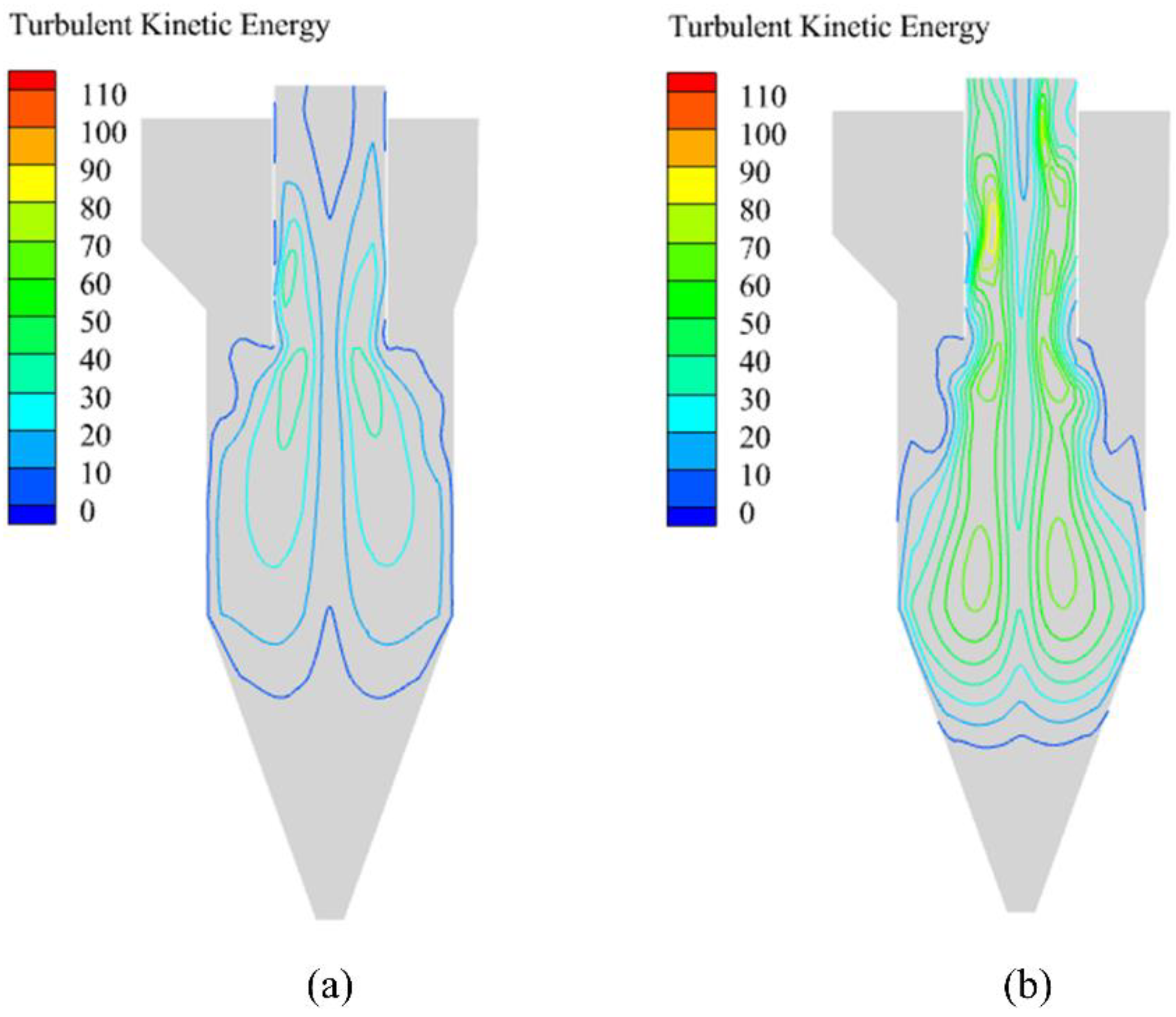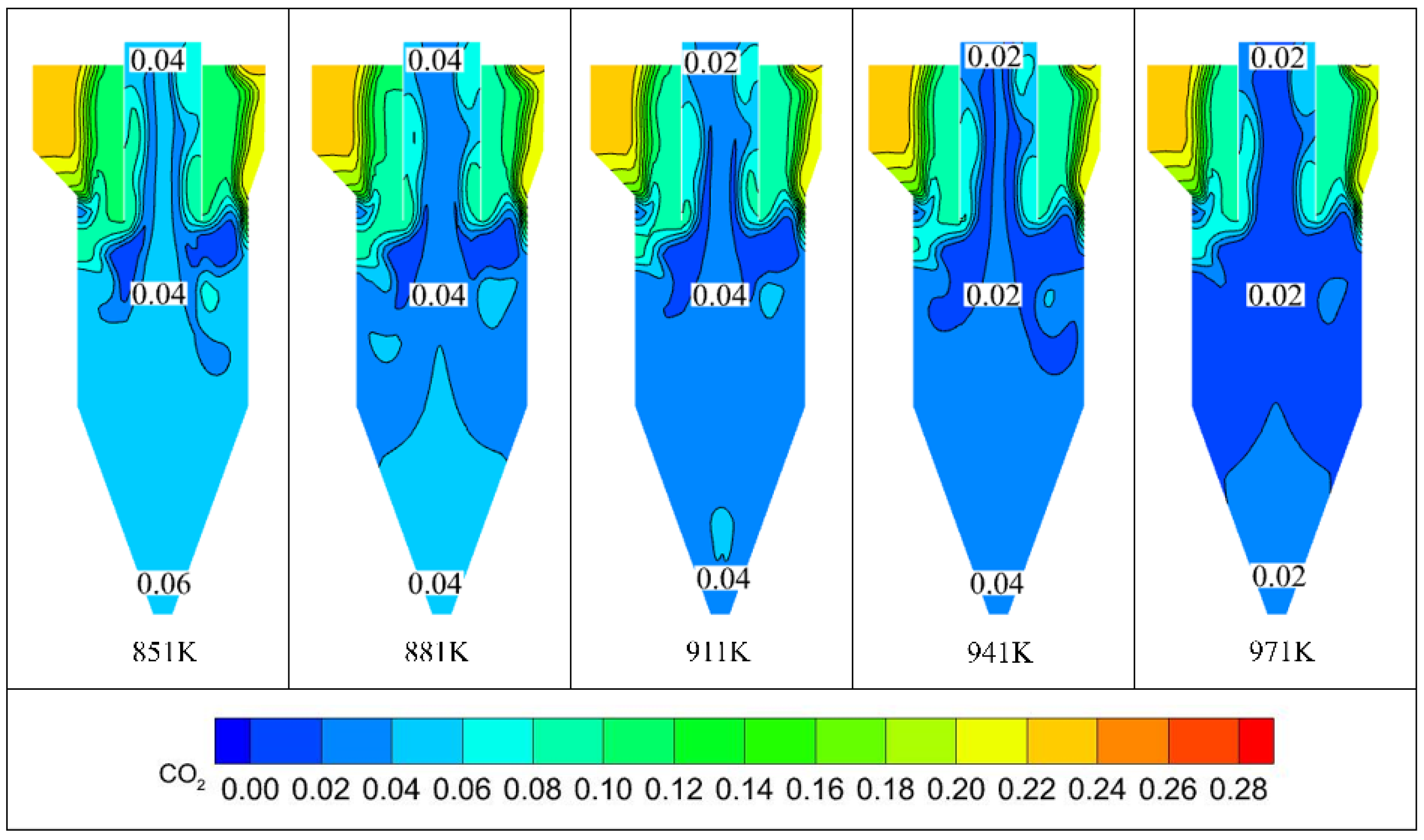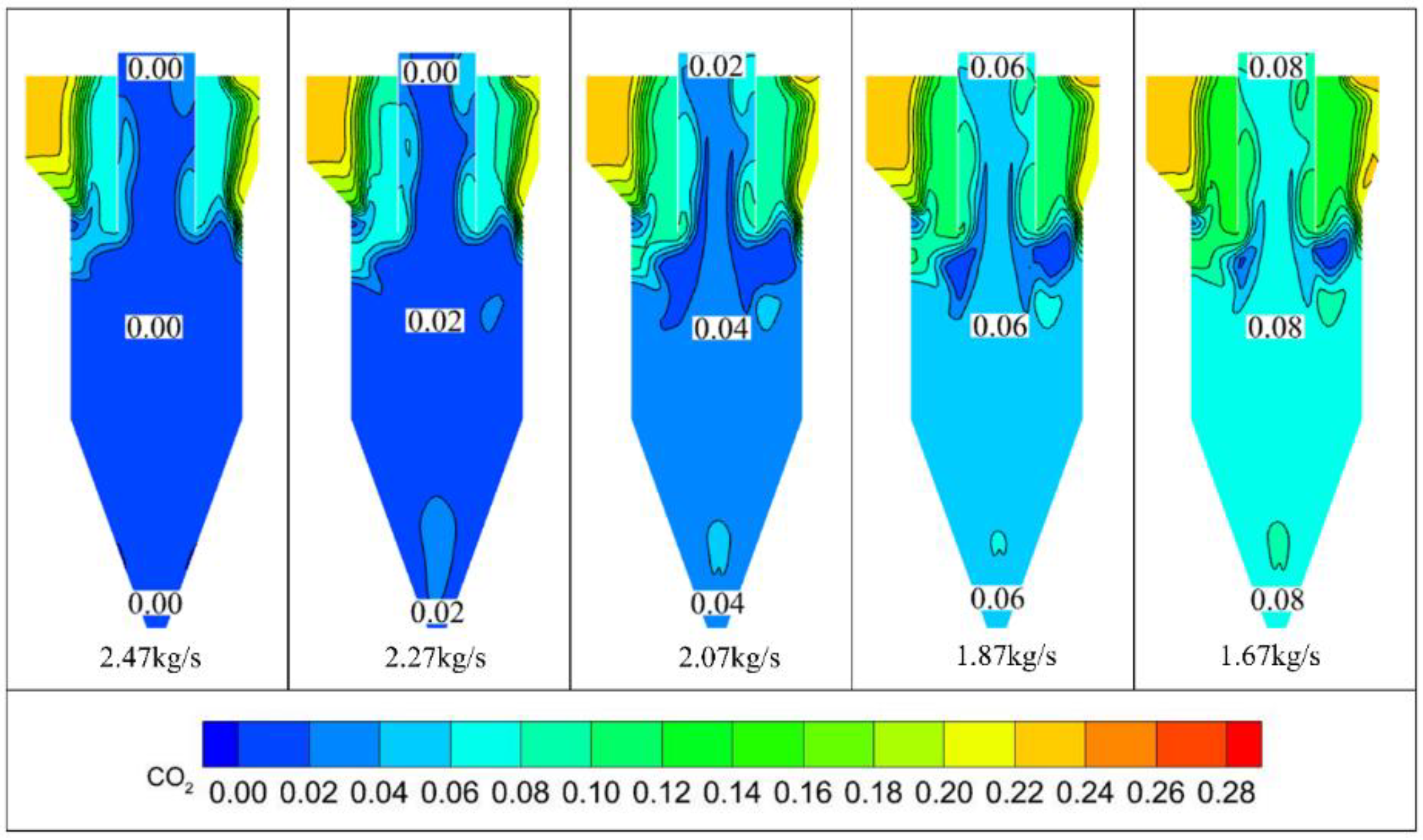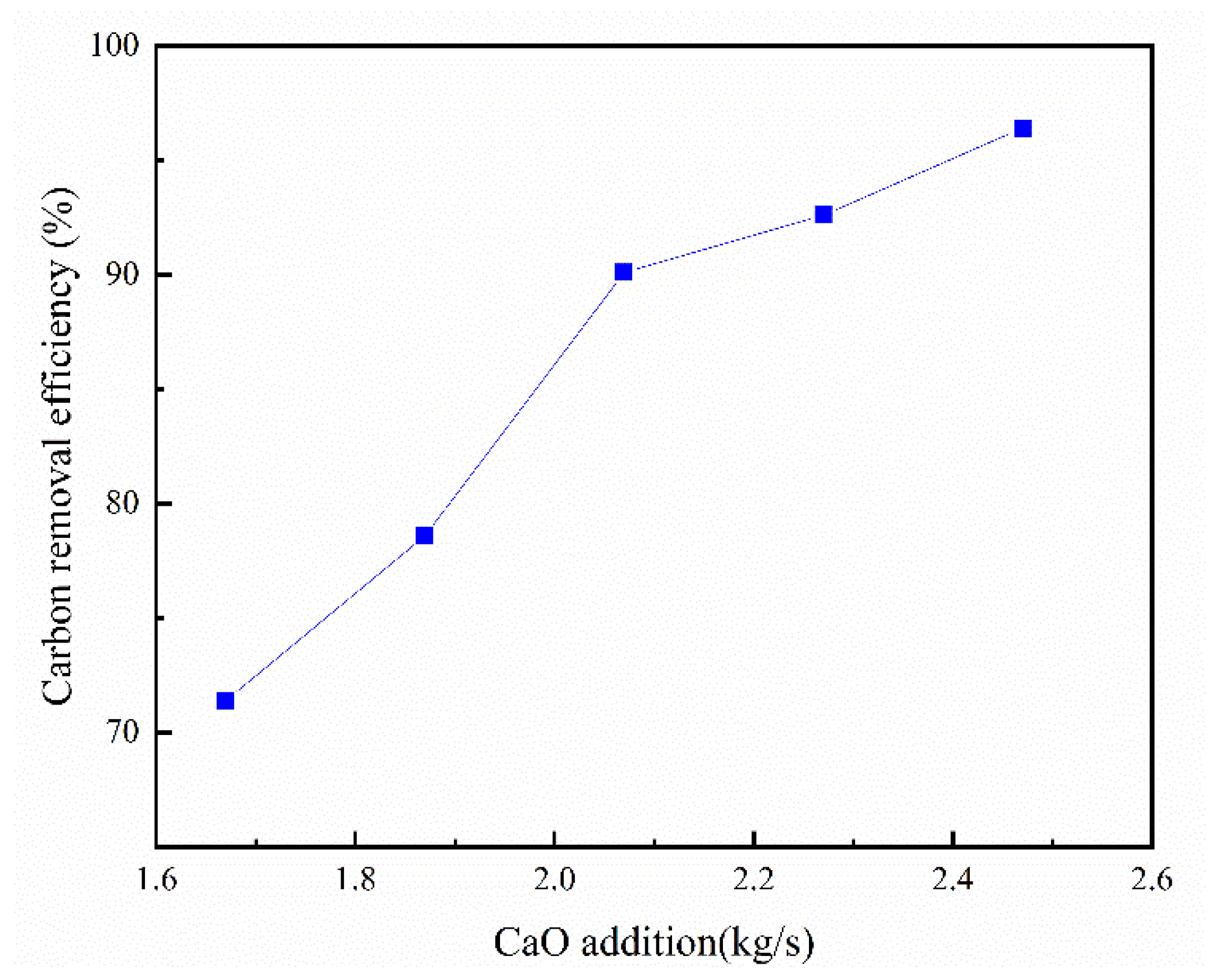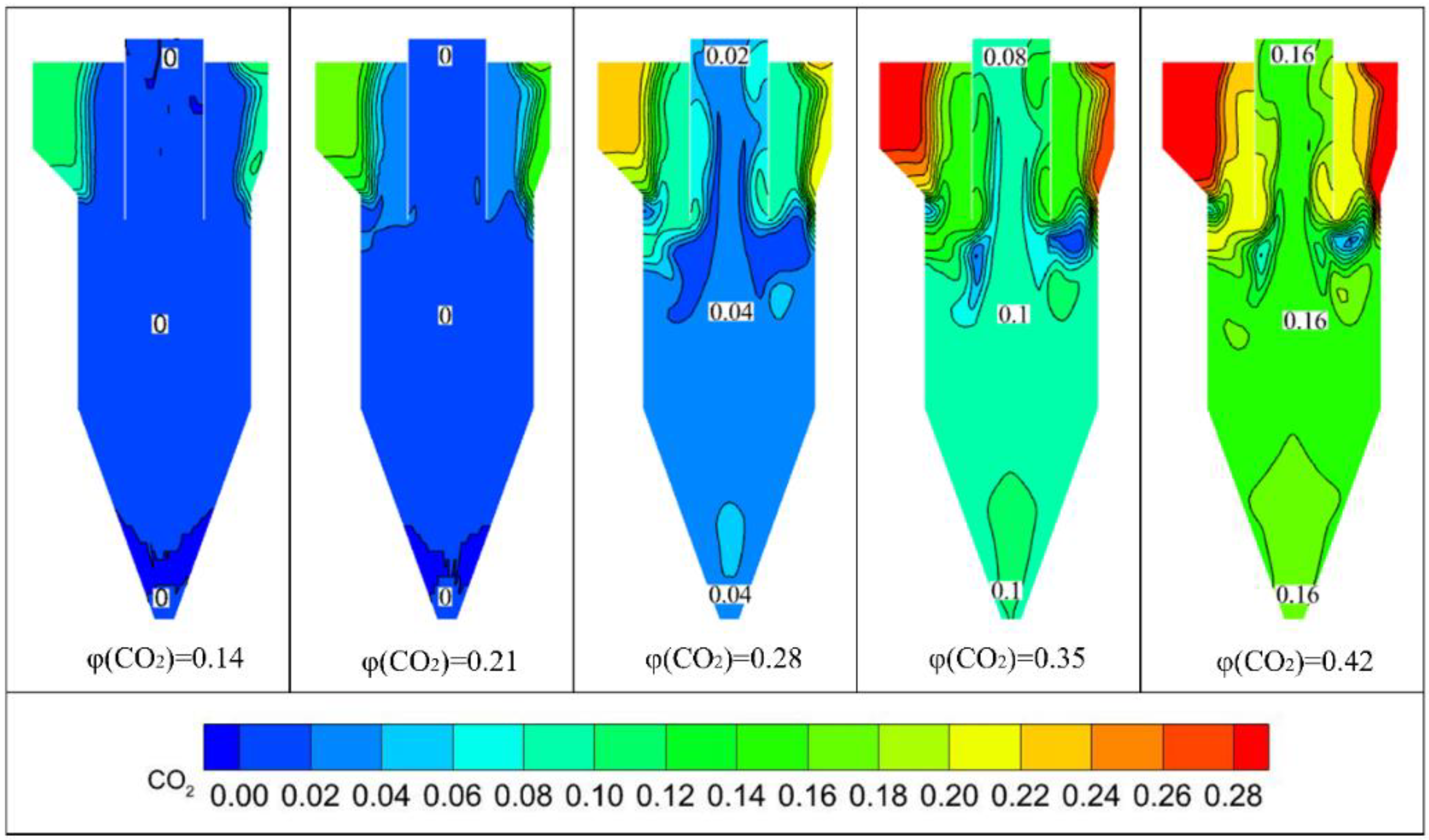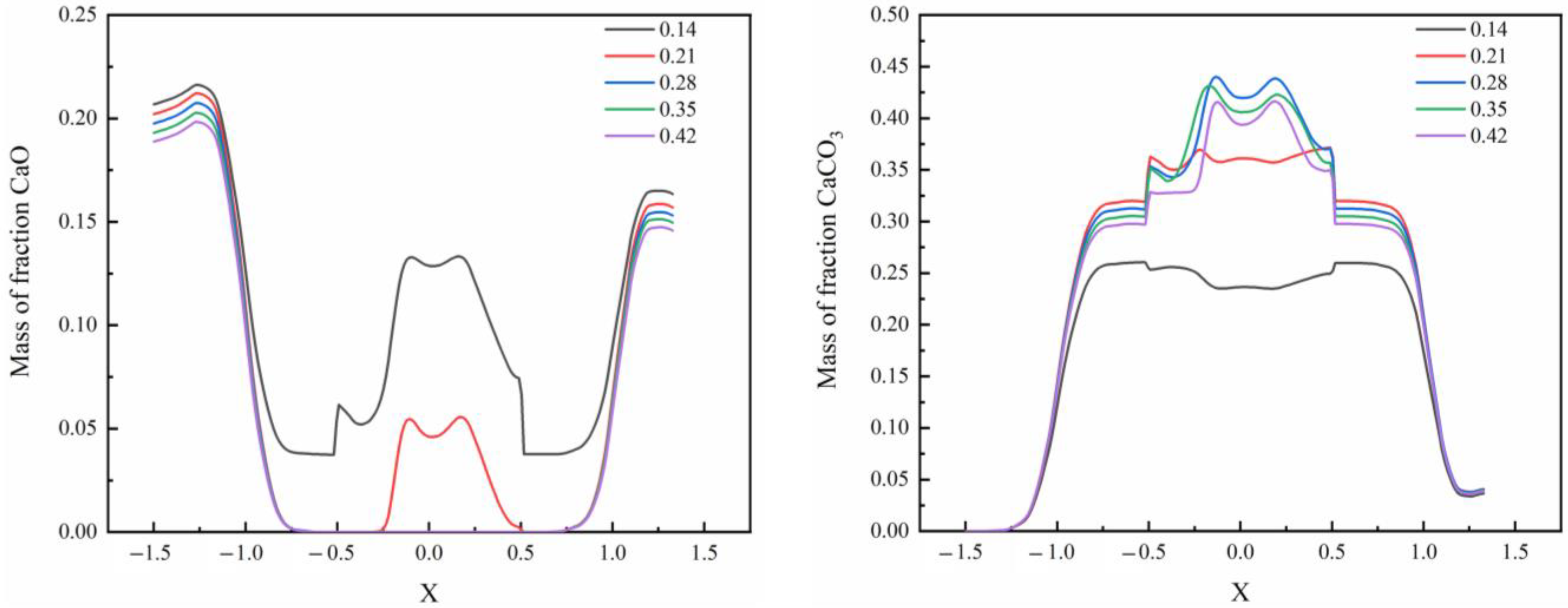1. Introduction
The greenhouse effect has been considered a major global climate problem in recent years, which severely negatively impacts the environment and the economy. Carbon (IV) oxide (CO
2) contributes to more than 60% of the greenhouse effect [
1]. CO
2 emissions from the cement industry account for 5–8% of the artificial CO
2 emissions [
2]. Currently, carbon emission reduction in the cement industry mainly includes optimization and energy-saving means, alternative raw fuels, carbon capture technology, etc. [
3,
4]. Carbon capture technology is widely utilized as an effective means of carbon reduction compared to the more significant economic investment in process optimization and the unstable quality of alternative fuels [
5].
Carbon capture technologies include the adsorption of adsorbents or solvents, membrane separation, low-temperature distillation separation, etc. [
6,
7,
8]. Among them, calcium-based carbon capture technology is widely used for its high adsorption capacity, excellent adsorption effect, and high-temperature resistance [
9]. Calcium-based carbon capture technology is a calcium looping (CaL) that uses the interconversion of CaO and CaCO
3 to separate carbon dioxide from flue gas. SILABAN et al. [
10] first studied the high-temperature separation process of CO
2 based on a gas-solid reaction (CaO (s) + CO
2 (g)↔CaCO
3 (s)) and confirmed the feasibility of absorbing CO
2 from high-temperature flue gas by the CaL method. Manovic et al. [
11] investigated the steam reactivation of adsorbents, and after reactivation, the adsorbents had better CO
2 capture properties than natural adsorbents; the average carbonation of reactivated adsorbents over ten cycles was nearly 70%, which was significantly higher than that of the original adsorbents (35–40%).
Two main ways to integrate calcium-based carbon capture technology with the cement industry are split CaL and integration CaL [
12]. Split CaL is a calcium cycle capture system set up at the end of the cement plant (after the preheater) to complete the capture and purification of CO
2 in the flue gas. Most reactor sites used to study CO
2 adsorption in flue gases by the split CaL process are fluidized-bed reactors [
13,
14,
15]. The fluidized bed reactor consists of the carbonation reactor and the calcination reactor. In the split CaL process, the CaO obtained by the calcination of quicklime into the calcination reactor is used as an adsorbent. The CaO adsorbent loses activity after several reactions [
16,
17]. Therefore, the CaO in the calcination reactor needs to be replaced in time, and it can be used as raw cement material to participate in the calcination process of cement clinker. Many studies have been conducted to simulate the split CaL process in cement [
12,
18,
19]. The study results show that the split calcium cycle method’s fuel consumption is significantly higher than the reference cement kiln without carbon capture. However, a significant portion of this additional energy input is utilized in the heat recovery steam cycle. Although the energy consumption is balanced, the additional burner will again produce CO
2 and cause environmental pollution.
Integration CaL is to use the preheater as a carbonation reactor and the decomposer as a calciner reactor to release high concentrations of CO
2 for carbon capture and utilization using the calciner under oxygen-rich conditions [
20,
21]. The CaO adsorbent used in the integration CaL is derived from the calcination product in the decomposition furnace rather than pure limestone [
22]. Moreover, the integrated CaL can eliminate the need for additional fuel and low fuel consumption [
23]. However, the technology requires oxygen-enriched combustion for the decomposer, increasing the economic investment. Using calcined products from the decomposer as the adsorbent can cause instability in the adsorption performance. From the results of laboratory tests, the capture capacity of cement raw meal is comparable to that of pure limestone, indicating that raw meal can be used as a sorbent to reduce CO
2 emissions during cement production [
24]. Lena et al. [
25] also confirmed the feasibility of using cement raw meal as an adsorbent in calcium cycling technology.
There are also many studies on new CaL process methods. Atsonios et al. [
26] used the ASPEN Plus software to describe the process modeling of the CaL implementation on a typical (bypass-free) five-stage preheater, detailing the CO
2 removal scheme process parameters. Spinelli et al. [
22] present a one-dimensional model of an entrained flow carbonator for a calcium cycling process in a cement plant and discuss the sensitivity analysis results on the main controlling process parameters. The results show that the carbonation reactor CO
2 capture efficiency is about 80% when the gas-to-solid ratio and adsorption capacity of the carbonation reactor is in the right combination in a gooseneck carbonator of lengths 2 to 80 m. Diego et al. [
27] analyzed a new calcium cycle process for cement plants based on a dual CaL process for studying reactor setups for CO
2 capture and CaCO
3 calcination.
However, these calcium cycle processes still have some drawbacks. Among the current CaL processes, the split CaL process requires additional fuel, which will generate CO
2 again. The integrated CaL process requires a decomposer for oxygen-enriched conditions, raising the economic investment. On the other hand, the carbonation reactors used in the CaL process studied so far are primarily fluidized beds or other reaction vessels. It is still relatively rare for carbonation reactors to be set up as cyclone separators. Therefore, a new process scheme is proposed in this paper which uses C5 preheater outlet raw material as the active CaO adsorbent, sets the carbonation reactor in the shape of a cyclone separator, and adds it to the preheater system, where the reaction occurs using high-temperature flue gas. The CaCO
3 generated by the reaction enters the carbonation reactor placed on the ground. Compared with other CaL process solutions, this solution fully uses flue gas waste heat, saves energy consumption, and avoids CO
2 regeneration [
12]. The carbonation reactor is located in the pre-calciner kiln system so that the flue gas does not carry the raw material away from the kiln, which affects the cement clinker firing process. Setting the carbonation reactor into a cyclone shape can ensure the smooth discharge of the reaction products after the reaction.
The exploration of the calcium looping process has been extensively studied, but there is limited actual research on optimizing the decarbonization efficiency parameter of the process. Therefore, the focus of this study is to analyze and optimize the decarbonization parameters in the carbonation reactor using CFD simulation software and to analyze the impact of introducing the carbonation reactor on the pre-calciner system. Compared to similar studies [
22], the results of this study demonstrate an improvement in the efficiency of the carbonation reactor under gas-solid reaction equilibrium conditions. Economic analysis shows that using flue gas waste heat saves energy consumption. The study’s results on the effect of the carbonation reactor on the pre-calciner system showed that the addition of the carbonation reactor decreased the separation efficiency. However, the decrease was insignificant and had a negligible impact on the pre-calciner system.
4. Analysis of Numerical Simulation Results
4.1. Model Validation Results
A cloud plot of the velocity distribution of the carbonation reactor gas is shown in
Figure 5. The gas enters the carbonation reactor at high speed from the worm shell in the tangential direction, and the space suddenly increases, resulting in a decrease in the velocity. The gas velocity increases sharply when it moves to the entrance of the inner cylinder due to the sudden decrease in the flow space. The gas velocity exceeds the entrance velocity resulting in the occurrence of the vortex. The gas velocity at the worm shell does not show axisymmetric distribution due to the deviation of the worm shell from the center of the cylindrical cylinder. The velocity on the side away from the worm shell inlet between the cyclone and inner cylinder was low, thus promoting the gas-solid separation effect.
A cloud diagram of the static pressure distribution of the carbonation reactor in gas pressure is shown in
Figure 6. The results showed that the static pressure value gradually decreased along the radial direction from the outside to the inside (
Figure 6). The inner cylinder had the same distribution as the cylinder; the static pressure was lowest near the center axis of the inner cylinder with negative values (
Figure 6). This phenomenon can be attributed to the forced vortex near the bottom of the inner cylinder, which forces the gas to rotate violently, resulting in a significant average pressure gradient. In addition, the results showed that the pressure gradually decreased at different heights along the axial direction. Negative pressure was observed at the center of the bottom of the reactor’s inner cylinder, forcing the gas to flow upward in the central part of the cone.
The above simulation results of the carbonation reactor’s single gas-phase cold flow field present velocity and pressure fields consistent with the general operation of cyclones in the literature, and the carbonation reactor can operate as usual [
31]. It can be concluded that the carbonation reactor is effective.
4.2. Temperature Field Analysis of Carbonation Reactor
The temperature cloud in the carbonation reactor is shown in
Figure 7. In the figure, the initial temperature of the gas is 911 K. The temperature of the flue gas decreases gradually along the flow direction. The temperature appears lower at the dust discharge port, where the temperature at the flue gas outlet is about 800 K. The temperature variation law is consistent with the operation principle of the preheater [
32].
4.3. Analysis of the Motion of Particles
Figure 8 and
Figure 9 show the trajectory and residence time of the solid CaO particles at different inlet velocities, respectively. In
Figure 8, the particles at different speeds are in a spiral motion, which, under the action of centrifugal force, are close to the inner wall of the reactor to form a thin layer of particle belt and rotate downward with the airflow to reach the bottom of the cyclone after entering the carbonation reactor. The airflow presents upward rotation at this time, carrying some particles to the flue gas outlet.
By analyzing the movement of the particles at different speeds in
Figure 8 and
Figure 9, it can be found that in the case of a speed of 18 m/s, the CaO particles stop moving downward and turn back upwards before reaching the cone, when a large number of particles are carried upward by the airflow and escape from the outlet, and cannot be trapped at the dust outlet as usual. When the speed is 15 m/s, most of the CaO particles continue to move to the bottom of the cone under the action of the cone, where the residence time is linearly distributed, the particles do not accumulate, and the gas-solid separation is realized. When the velocity is 12 m/s, the streamline distribution of the particles is relatively messy, and the residence time in the cone part is the same, which increases the risk of particles being trapped inside the cone. To sum up, the velocity of entrained particles should be moderate, neither extremely large nor extremely small, since the excessive speed will cause particles to fail to achieve gas-solid separation. In contrast, minimal speed will cause particles to gather at the dust outlet and increase the residence time of the particles. Therefore, the optimal running speed was set as 15 m/s in this study.
4.4. Turbulent Kinetic Energy of the Flow Field
Figure 10 presents the turbulent kinetic energy diagrams in a carbonation reactor.
Figure 10a shows the turbulent kinetic energy diagram in the gas phase, and
Figure 10b shows the turbulent kinetic energy diagram after the addition of the CaO particles (2.27 kg/s). The turbulent kinetic energy is relatively small at the wall and central area of the reactor but relatively large at the bottom area of the inner cylinder, indicating the most vital turbulent airflow in this area. The turbulent kinetic energy of the turbulent flow in the cylindrical part is symmetrically distributed; the lower the axial direction is, the smaller the turbulent kinetic energy becomes, or even no turbulent flow phenomenon will be observed. Comparing
Figure 10a,b, it can be seen that the addition of the CaO particles leads to an increase in the turbulence intensity of the carbonation reactor. The phenomenon of turbulence is subject to both advantages and disadvantages. On the one hand, it strengthens the transfer and reaction process, while on the other, frictional resistance and energy loss are greatly increased. According to the above analysis of the turbulence phenomenon, it can be obtained that the carbonation inversion is relatively intense in the inner cylinder and cylinder parts. However, the addition of particles will lead to an increase in turbulence intensity, which in turn leads to easy wear in the inner cylinder part. Therefore, the turbulent kinetic energy size should be controlled reasonably.
4.5. Analysis of the Separation Efficiency
When the dust-laden airflow moves, the dust gives the airflow a force that can locally change the movement state of the airflow, i.e., the resistance of the gas. At the same time, the airflow also gives the dust a reaction force of equal size, known as the power of the dust. The size of this resistance determines the resistance loss of the cyclone, while that of the power directly affects the recovery rate of the dust.
The separation efficiency of the carbonation reactor matters considerably for the collection of reaction products. The airflow in the carbonation reactor rotates downward at high speeds to reduce the pressure at the top, causing part of the airflow to carry fine dust particles and rotate downward along the outer wall of the exhaust pipe to be discharged from the exhaust pipe. As a result, the separation efficiency of the carbonation reactor cannot be maintained at 100%. The calculation formula and results of the separation efficiency are as follows:
where,
is the separation efficiency,
is the dust outflow at the dust outlet (kg/s), and
is the dust inflow at the inlet (kg/s).
According to the simulation results,, , and the separation efficiency of the carbonation reactor is 92.5%. A high separation efficiency can effectively reduce the amount of fly ash and ensure the collection of most of the calcium carbonate produced from the reaction.
4.6. Verification of Carbonation Reactor Decarbonization Efficiency under Initial Conditions
Under the initial reaction conditions with a reactor temperature of 911 K, a CO2 concentration of 0.28 in the flue gas, and a CaO addition rate of 2.27 kg/s, the mass fraction of CO2 at the flue gas inlet is 0.28 and the mass fraction of CaO is 0.31. The simulation results after the carbonation reaction show that the content of CaO in the flue gas outlet and dust outlet is zero, indicating that all the CaO has participated in the reaction. The average mass fraction of the calcium carbonate at the dust outlet surface is 0.56. The average mass fraction of the CO2 at the flue gas outlet surface is 0.021, indicating that the mass fraction of the CO2 participating in the reaction in the flue gas is 0.259.
To verify the reliability of the carbon removal efficiency, the stoichiometric ratio of reactants and products can be calculated using chemical reaction relationships. In the carbonation reaction, the chemical stoichiometric relationship between CaO, CO
2, and CaCO
3 is 1:1:1; 1 mol of CaO reacts with 1 mol of CO
2 to produce 1 mol of CaCO
3. The molar mass of CaO is 56.08 g/mol, the molar mass of CO
2 is 44 g/mol, and the molar mass of CaCO
3 is 100.09 g/mol. Therefore, the mass ratio of reactants and products can be expressed as follows:
According to the above calculation, the mass ratio of CaO to CO2 in the carbonation reaction is 1.28, and the mass ratio of CO2 to CaCO3 is 0.44. The numerical simulation results show that under the initial conditions, the mass fraction ratio of CaO and CO2 undergoing carbonation reaction is 0.31/0.259 = 1.2, with an error of 6% compared to the actual mass ratio, and the mass fraction ratio of CO2 and CaCO3 is 0.259/0.56 = 0.46, with an error of 5% compared to the actual mass ratio. The slight difference between the numerical simulation results and the calculated values based on the chemical reactions indicates a high degree of consistency, suggesting that the carbonation reaction occurring inside the reactor proceeds as expected.
4.7. Analysis of Factors Influencing Carbon Removal Efficiency of Carbonation Reactors
4.7.1. Effect of Different Temperatures on the Carbon Removal Efficiency of the Carbonation Reactor
The CO
2 fraction of the carbonation reactor at different temperatures on the XY cross-section is shown in
Figure 11. The initial parameters of the reaction were set as follows: The mass flow rate of the added CaO was 2.07 kg/s and the volume fraction of CO
2 was 0.8. As can be seen from
Figure 11, the CO
2 concentration in the reactor gradually decreased with the increase of the reaction temperature. When the temperature is 851 K and 881 K, the volume fraction of carbon dioxide out of the reactor is 0.04. When the temperature is 911 K, 941 K, and 971 K, the amount of carbon dioxide out of the reactor is 0.02. The increase in reaction temperature leads to a higher conversion rate of CaO, which, in turn, can adsorb more CO
2 gas, resulting in a decrease in the concentration of CO
2 at the flue gas outlet. This phenomenon is consistent with the experimental characteristics of CaO adsorbing CO
2 [
33].
As shown in
Figure 12, the carbon removal efficiency of the carbonation reactor varies with temperature. The carbon removal efficiency is calculated from the surface average CO
2 concentration at the flue gas inlet and outlet. From
Figure 12, it can be obtained that the carbon removal efficiency of the carbonation reactor increases gradually with the temperature increase. When the temperature is greater than or equal to 911 K, the carbon removal efficiency of the carbonation reactor can reach more than 90%. Considering the carbon removal efficiency, the reaction temperature of the carbonation reaction can be chosen to be greater than or equal to 911 K. However, in actual production, it is necessary to consider the cost. Although the increase in temperature can improve the carbon removal efficiency, the increase in temperature requires additional fuel to provide heat, increasing the cost, and the specific value needs to be weighed.
4.7.2. Effect of Different CaO Addition on the Carbon Removal Efficiency of the Carbonation Reactor
Figure 13 shows the CO
2 composition diagram of the carbonation reactor on the XY cross-section under different CaO additions. The initial parameters of the reaction were now set as follows: The reaction temperature is 911 K, and the volume fraction of CO
2 is 0.28. It is revealed that with the increase in CaO addition, the concentration of carbon dioxide in the reactor decreases gradually. The outlet volume fraction of CO
2 is as low as zero in the case of a CaO mass flow rate of 2.47 kg/s and 2.27 kg/s. The amount of removed CO
2 is 0.02, 0.06, and 0.08 when the CaO mass flow rate is 2.07 kg/s, 1.87 kg/s, and 1.67 kg/s, respectively, indicating that more CO
2 can be absorbed by increasing the amount of added CaO. As the amount of the adsorbent CaO increases, according to the chemical reaction equilibrium law, more CO
2 can be adsorbed, resulting in a lower concentration of CO
2 at the flue gas outlet.
The carbon removal efficiency of the carbonation reactor varies with the amount of added CaO, as shown in
Figure 14, where it can be observed that the carbon removal efficiency of the carbonation reactor gradually increases with the increase in the CaO addition. When the CaO addition amount is 2.07 kg/s and above, the carbon removal efficiency of the carbonation reactor can reach more than 90%. Therefore, considering the carbon removal efficiency, the CaO addition amount of 2.07 kg/s and above could be chosen. However, the active CaO used in this paper was taken from the C5 down-feed pipe. The amount should be manageable, so the specific value should be decided according to the situation.
4.7.3. Effect of Different CO2 Volume Fraction on the Carbon Removal Efficiency of Carbonation Reactor
Figure 15 is the CO
2 composition diagram of the carbonation reactor at the XY cross-section under different CO
2 volume fractions. The initial parameters of the reaction include a temperature of 911 K and a CaO mass flow rate of 2.07 kg/s. As shown in the figure, when the CO
2 volume fraction at the inlet is 0.14 and 0.21, the carbon dioxide volume fraction at the carbonation reactor outlet is 0, while in the case of a CO
2 volume fraction at the inlet of 0.28, 0.35, and 0.42, the volume fractions of carbon dioxide are 0.02, 0.08 and 0.16, respectively. As the volume fraction of CO
2 increases, the added active CaO is insufficient to absorb more CO
2, leading to a high concentration of CO
2 at the flue gas outlet. This phenomenon is caused by the inappropriate ratio of the two reactants. Therefore, the volume fraction of CO
2 should be proportional to the amount of CaO added.
As shown in
Figure 16, the carbon removal efficiency of the carbonation reactor varies with the volume fraction of CO
2. Specifically, the carbon removal efficiency of the carbonation reactor gradually decreases with the increase in the CO
2 volume fraction, which can reach 100% when the volume fraction of the CO
2 is 0.14 and 0.21. In contrast, in the case of a CO
2 volume fraction of 0.28, the carbon removal efficiency can reach 90%. However, when the CO
2 volume fraction is less than 0.28, the carbon removal efficiency becomes relatively low. Therefore, to ensure removal efficiency, the volume fraction of CO
2 should not be extremely large. The effect of changes in the CO
2 volume fraction on the carbon removal efficiency is also related to the addition of the adsorbent CaO.
Figure 17 shows the changes in the CaO and CaCO
3 along the X-axis at the intersection of the Y = 6.13 and Z = 0 lines for different CO
2 concentrations. In the figure, when the CO
2 content in the flue gas is 0.14 and 0.21, there is still some unreacted CaO in the inner cylinder. When the CO
2 content is 0.28, the highest amount of CaCO
3 is generated. However, although the CO
2 concentration continues to increase afterward, the amount of CaCO
3 generated no longer increases. This is because the chemical reaction reaches equilibrium when the CO
2 concentration in the flue gas is 0.28. Even though the CO
2 concentration increases, there are no longer sufficient amounts of CaO adsorbents added to the system to continue the reaction.
In summary, when the temperature is 911 K, the addition of CaO is 2.07 kg/s, and the CO
2 volume fraction is 0.28, the chemical reaction reaches equilibrium, and the carbon removal efficiency reaches 90%. Compared with similar research [
22], the carbon capture efficiency of the carbonation reactor has been improved under the condition of a gas-solid reaction equilibrium. When the carbon removal efficiency reaches 90%, the carbonation reactor has a good carbon removal function. Although increasing the temperature can improve carbon removal efficiency, it also leads to increased energy consumption. The temperature of the carbonation reactor is determined by the amount of coal powder added to the pre-decomposition kiln system. The coal used by the cement plant studied in this paper costs 1722 CNY per ton. Assuming an increase in the reaction temperature by 50 K, the required coal consumption would be 434 kg/h, with an annual economic input of 6.54 million CNY. Since a carbon removal efficiency of 90% already demonstrates excellent carbon removal capabilities, there is no need to increase the economic input further. Therefore, selecting the reaction condition with a carbon removal efficiency of 90% as the optimal condition is reasonable. However, considering the mutual influence of various factors, a full-factor analysis of each factor is needed below.
4.8. Optimal Parameter Analysis
This paper considered three influencing factors, including temperature, CaO addition, and CO
2 volume fraction, and three-level values were taken for each factor. Then, a three-factor three-level experiment was required, and
combinations of experiments were required for a full-scale experiment, and the number of replicates for each combination was not considered. If the experiment is arranged according to
orthogonal table, only nine times are required. In
,
is the code of the orthogonal table, 9 is the number of experiments, 3 is the number of levels, and 4 is the maximum number of factors that can be arranged.
Table 6 presents the factor level table.
The simulation design scheme and simulation results are shown in
Table 7. A direct comparison of the data in
Table 7 shows that simulation experiment nine produces the best results among these nine experiments. This suggests that a reaction temperature of 911 K, a CaO addition rate of 2.07 kg/s, and a CO
2 volume fraction of 28% is the optimal reaction condition based on economic and carbon removal efficiency considerations.
Table 8 shows the analysis of the simulation results, where K1, K2, and K3 are the sum of the values of the carbon removal efficiency corresponding to individual levels in each factor; k1, k2, and k3 are one-third of K1, K2, and K3; and R represents the extreme difference, which is the maximum value minus the minimum value of the corresponding column k.
The R values in
Table 8 show that the influencing factors in this experiment have a significant order of magnitude. The range of the CO
2 volume fraction factor is the largest, up to 21.4, followed by the CaO concentration factor, and the temperature factor has the smallest range of 5.3. This indicates that the effect of the CO
2 volume fraction is greater than that of the CaO addition and temperature. Therefore, in practical operation, if one wants to improve the carbon removal efficiency, the volume fraction of CO
2 and the amount of CaO added should be the primary factors to consider.
4.9. Analysis of the Impact of the Carbonation Reactor on the Pre-Calciner System
The addition of a carbonation reactor mainly affects the C1 and C2 preheaters in the cement pre-calciner kiln system. Adding a carbonation reactor changes the gas velocity and pressure in C1 and C2, affecting the particle separation efficiency at the outlet of the primary preheater.
Table 9 and
Table 10 show the changes in velocity and pressure at the outlets of the C1 and C2 preheaters before and after the addition of the carbonation reactor. “Original” represents the state before the addition of the carbonation reactor, and “Current” represents the state after the addition. Data in
Table 9 and
Table 10 show that the velocity and pressure at the outlets of the C1 and C2 preheaters in the original cement pre-calciner kiln system are consistent with the actual data, indicating the reliability of the model. The study found that the addition of a carbonation reactor increased the gas velocity and reduced the pressure at the outlets of C1 and C2, thereby affecting the separation efficiency.
Table 11 shows the changes in separation efficiency at the outlet of C1 before and after the addition of the carbonation reactor. The separation efficiency of the current C1 outlet has decreased by 1.3%, but the decrease is not significant. In summary, the addition of a carbonation reactor increases the velocity and reduces the pressure at the outlets of C1 and C2, resulting in a decrease in separation efficiency at the outlet of C1. However, due to the slight decrease, the impact on the cement pre-calciner kiln system is small.
